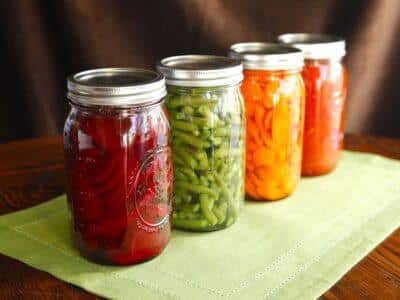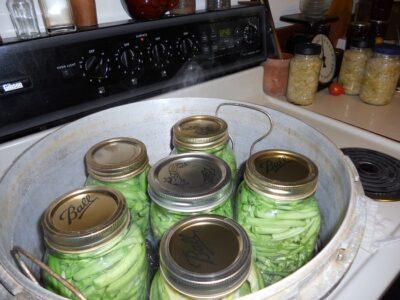|
Listen To The Article
|
Do you love the idea of canning veggies from your garden but refrain from doing so for fear of botulism? Does your home canning consist of only basic jams and jellies because you’re convinced that if you attempt to can green beans you’ll do it improperly and kill your family?
You’re not alone. Botulism strikes fear in the hearts of home canners everywhere. Botulism toxin is one of the deadliest neurotoxins in the world. Once it enters your body, it blocks nerve function, causing muscle paralysis and eventually death.
The name for botulism comes from botulus, the Latin word for sausage. Originally known as Kerner’s Disease, one of the earliest outbreaks was recorded in 1793 by the physician Justinus Kerner in the town of Wildbad, Germany. Many people fell sick and died after eating contaminated sausage.
Today, instances of foodborne botulism at home often come from home-canned goods that were processed improperly. But the good news is that botulism contamination in home canning is completely preventable. You can safely preserve and eat fruits, vegetables, meat, poultry, seafood, anything — as long as you take the necessary precautions.
Clostridium Botulinum
So what is botulism, anyway? Clostridium botulinum is a soil-borne, single-celled bacterium that is intolerant of oxygen. When exposed to oxygen, it converts into an armored spore that can lay dormant for hundreds of years. But when a botulism spore finds itself in an anaerobic environment once again, it re-animates back into its bacterial form. In this form it grows, reproduces and produces botulism toxin, which is so lethal that even one microgram is enough to kill you.
Inert botulism spores are found everywhere: in oceans and lakes, in the silt at the bottom of streams, in horse and cattle manure, and in the soil in your backyard garden. It’s more common in the West than in the rest of the United States because the soil from the Rocky Mountains to the Pacific Ocean contains an especially high count of botulism spores.[i] This, combined with the added factor of high altitude in the Mountain West, makes botulism especially concerning for home canners there.
Prepare now for surging food costs and empty grocery store shelves…
Because botulism is ever-present in the soil, it doesn’t matter how sanitary you are in your home canning; botulism can be found in almost all foods. But since the bacteria can’t grow in the presence of oxygen, it’s harmless in fresh foods. That’s why you’ll never get botulism from eating fresh tomatoes from your garden.
Canned foods are a different story. To re-animate and grow, botulism spores require warm temperatures, moisture, and an oxygen-free, low-acid, low-sugar environment. So when you seal fresh foods in canning jars and store them at room temperature in your cupboard, you’ve created the perfect environment to grow the world’s deadliest neurotoxin. Since the toxin is odorless and tasteless, you can open a jar from your pantry and eat toxic food without realizing it. Within 12 to 36 hours symptoms start setting in, and a few days after that you could be dead.
That, of course, is the worst-case scenario. The death rate from botulism once was 70 percent, but since the invention of artificial respirators, it has dropped to only 5 percent. But in a collapse or crisis situation, you can’t depend on respirators and hospitals to take care of your family. All things considered, it’s better to avoid botulism poisoning by canning food correctly.
Water Bath Canner Versus Pressure Canner
The most important thing you can do to avoid botulism poisoning is to choose the correct canner to process your food. Water bath canners or steam canners, which are commonly used for jams and jellies, won’t do the trick, and here’s why: To kill clostridium botulinum spores, you have to get food to a temperature of 250° F (121° C) for at least three minutes. But water at sea level boils at only 212° F (100° C), so it’s impossible to achieve a high enough temperature in a water bath canner. If you live at a higher elevation, the atmospheric pressure is even less, so the boiling temperature is even lower. You can boil your veggies all day, but that will only kill active botulism bacteria, not the spores, leaving them to grow again and produce more toxin when conditions are right.
The only way to get the temperature high enough to kill botulism spores is to increase the pressure so that the boiling temperature is raised. And that’s where the pressure canner comes in. In a pressure canner, you add 10 to 15 pounds of pressure so that you can get your food up to the requisite 250° F to kill botulism spores. (Actually, home canners can only raise the temp to 240° F, or 115° C; to kill the spores at this lower temperature, the food must be exposed to that temperature for a longer period of time to destroy the spores.)
So when is it okay to use a water bath canner? Why is it okay to use one to process jams and jellies? The answer is acidity. Botulism will only grow in an anaerobic, low-acid, low-sugar environment, so foods can be processed at a lower temperature if they’re very acidic, with a pH of 4.6 or lower. This includes fruit, so that’s why it’s okay to process jams, jellies, fruit preserves and syrups in a water bath canner, as long as you boil them long enough. (Follow tested and tried instructions for processing times, and keep in mind that you’ll have to add a minute of boiling time for every 1,000 feet of elevation.)
Low acid foods should never be processed in a water bath canner but always in a pressure canner; this includes green beans, carrots, peas, corn, asparagus, beets, spinach, pepper, squash, and potatoes.
Tomatoes are a special case. In your grandmother’s day, they were often canned in a pressure canner, but many tomatoes we eat today are hybrid varieties with lower acid content. If you want to process them in a water bath canner, you’ll need to add lemon juice, citric acid or vinegar to up the acid content. Make sure you use a reliable recipe to get the quantities right, or simply can tomatoes in a pressure canner instead.
What about foods like salsa that contain a mixture of several ingredients? When you’re dealing with a mixture of vegetables, process your jars according to the food that needs the longest processing time. For example, a salsa containing corn and tomatoes must be processed for the recommended time required for corn.
Requisite Time and Pressure
There are two types of pressure canners: those with a dial gauge and those with a weighted gauge. A dial gauge is easier to read but must be calibrated properly; every year you should take yours to your local extension services office to have it checked. A weighted gauge, on the other hand, never needs calibration. It’s important to make sure your gauge is accurate; otherwise you could think that you’re canning food safely when you’re really not.
New All-Natural Capsule Protects You From Dangerous Toxins And Pollutants!
As with water bath canning, you should use reliable canning recipes to determine how much processing time each food needs. The pressure you should use depends upon the elevation where you live; a good rule of thumb is that foods should be canned with 11 pounds of pressure at sea level, and you should add .75 pounds of pressure for every 1,000-foot increase in elevation.
Avoid Cans That May Have Been Contaminated
No odors or flavors accompany botulism, so it can easily go undetected. Commercially canned goods are required to undergo a “botulinum cook” at 250° F for three minutes, so they rarely cause botulism, although there have been exceptions. For commercially canned food or home-canned goods, the same rules apply: If the container or lid is leaking or bulging, that indicates gas production from bacterial growth, so throw it out. If the container spurts foam or liquid when opened, or if air rushes in or out, throw it out. If you suspect that a can is contaminated with botulism, don’t taste it and don’t pour it down the garbage disposal. Dispose of it somewhere where children or pets can’t be exposed to it. If you spill it anywhere, clean the area with water and bleach. Don’t touch the contaminated food, because botulism bacteria can absorb through the skin and can be just as harmful as if you ingest it.
Contaminated food usually won’t show any signs of botulism at all. If you’re not sure if a jar of food was processed correctly, boil it for at least ten minutes (if you live above 1,000 feet, add one minute of boiling time for each additional thousand feet of elevation), and then eat it promptly.
Resources for Canning
Be sure to read Off The Grid News’ articles on canning with a pressure canner and canning low-acid vegetables. And most importantly, take the guesswork out of processing times and pressures by following reliable canning recipes. Your mother or grandmother probably used the Ball Blue Book Guide to Home Canning; these days it’s just as easy to go to Ball’s website, where you can access dozens of proven recipes with detailed instructions on how to can food safely.
You can also check out the USDA Complete Guide to Home Canning, which tells you how to can just about anything: fruit, vegetables, tomatoes, poultry, meat, seafood, fermented food and pickled vegetables. You can also check out the National Center for Home Food Preservation website, which includes a “Find Your Altitude” feature to help you determine the elevation of your hometown.
Another great resource is your nearest Cooperative Extension office. The Cooperative Extension system is a nationwide educational network. Each U.S. state has a state office at its land-grant university and a network of local offices, all of which are staffed by experts who provide research-based practical information on agriculture and food preservation. On the USDA website you can find your local extension office, where you can go to ask questions and get instructions from certified home canning experts who can tell you how to safely can at your elevation. They can clear up any doubts you have so that you can be sure you’re canning your food safely.
Do you have any tips on how to avoid botulism? Share them in the section below:
Sign up for Off The Grid News’ weekly email and stay informed about the issues important to you
[i] Kendall, P. “Botulism, no. 9.305.” Colorado State University Extension. <https://www.ext.colostate.edu/pubs/foodnut/09305.html>, last modified 8/8/2014, accessed 01/2015.
 Off The Grid News Better Ideas For Off The Grid Living
Off The Grid News Better Ideas For Off The Grid Living






